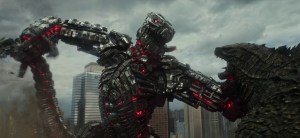Remember Cybernary?
I had completely forgotten about Cybernary.
Videos by ComicBook.com
She was a character created by Nick Manabat at Wildstorm back in the 90s. Sadly, Manabat died tragically young of cancer. He penciled some Cybernary backups for the original “Deathblow” series and that’s about all of his comics work.
She appeared here and there in the Wildstorm universe over the years. Most notably for me, she was one of the stars of “Savant Garde,” a team Wildstorm book I liked a whole heck of a lot that few read. (It had great art by Ryan Odagawa, with strong scripts from Barb Kesel.)

OK, so I hadn’t completely forgotten about the character. I had, however, forgotten about “Cybernary 2.0,” the six issue mini-series through Wildstorm in 2001 that I found in a longbox this weekend.
The big draw to it is the art by Eric Canete. It’s ridiculously good, and a lot of what you’d expect from him. It plays to many of his strengths.
It’s filled with cyborgs and tech stuff and a lot of neon signs drawn in perfect Geoff Darrow-ish three dimensions.

It’s a real shame that he’s so good that comics can’t afford to keep him.
After the Wreckage
Joe Harris’ story is set on the island nation of Gamorra in the wake of “The Authority” #4. Spoilers for the classic Warren Ellis/Bryan Hitch story: The Authority drive their ship into Gamorra and take out its horrible leader, Kaizen Gamorra.
In the rubble of the capital building, some kids chance across Cybernary. She’s the cyborg daughter of Kaizen (long story, most of which I didn’t read) and will soon rise to lead her country out of its post-Authority malaise. There’s some resistance to that from corners who think it wouldn’t make good business for them.
There’s a lot of bullets flying, too.
The story is serviceable, as a plot unto itself. It’s a standard sort of “Chosen One” plot with Cybernary taking the title. There are warring political factions surrounding her. She needs to figure out who she is to properly do her job. She must somehow bridge the gap between the cyborgs and the humans of Gamorra. She has a foot in each world, so she’s uniquely qualified.
Harris’ script has a strong ending, but I found my attention wandering through most of the middle. Part of it is the expendable no-name or low-level politicians and cyborgs. After awhile, I was losing track of who was on who’s side, despite Harris inserting their names in enough word balloons to keep the readers in touch.
I may have been too distracted soaking up Canete’s art to fully dive into the story.
Canete Steals the Show
I opened this series up for Eric Canete’s art, and it doesn’t disappoint. I’m impressed with how skilled his art is here, from 17 years ago. This isn’t a case of a young up-and-comer getting work in an Image studio system before their time. This stuff is top-notch pro level material that would work as well today.
There might be a few storytelling weaknesses here and there, but nothing a well placed word balloon can’t clear up for an unsuspecting reader.
Canete’s style is all over this book, from the twisted wiry characters to the high tech and highly detailed cyborgs and background bric-a-brac. His style is instantly recognizable.
And, yes, he does draw The Authority for a couple panels in the last couple of issues.

Juan Vlasco’s inks are perfect over Canete’s pencils. He has a slick like, neatly outlining all the important items in every panel, while keeping a careful eye on the line thicknesses. He adds more dimensionality and detail with his line. Looking at Canete’s art today, I’d expect to see some more crosshatching/feathering/fancy inks, but this slicker line from 17 years ago looks great, too.
The colors start a little dark in the first issue, but then it looks like the colorist, Carrie Strachan, adjusted for the paper print quality and brightened everything up a shade or two for the rest of the series.
There is a lot of brown and drab pages in this series, but much of it takes place in dark areas, like in the dark underground of a fallen building. It fits.
And, most of all, it doesn’t hide the art in a bad way.
Wildstorm Lettering
Just to be complete, there’s lettering. I never liked Wildstorm’s general approach to lettering. It’s one of the styles I railed against when hand lettering was going away and I was missing it. Wildstorm’s house style looked too perfect and too computer-generated. There’s something about those perfect oval balloons and thin letters that bother me.
If you don’t believe me that Wildstorm had a house lettering style, take this small fact into account: There are at least four different letterers credited in this six issue mini-series, and they all look identical.
Here’s a funny note: The lettering is credited or co-credited in two of the issues to Robbie Robbins from Idea & Design Works. Yes, that’s the predecessor to today’s IDW publisher.
The Bad News
This book is long out of print and not available digitally. You’ll need to do a little digging to find these issues.
If you liked “Love Run Kill,” Canete’s last Image Comics mini-series, you’ll like this one, too. It’s a much earlier work and might look stiff in comparison, but taken on its own merits, it’s a very accomplished piece of work. If you ever see it in a back issue bin or a forgotten corner of your own longbox collection, open them up and take a look. They’re really good.
PipelineComics.com|| Twitter || Instagram || E-mail || YouTube









